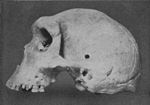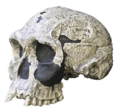Homo antecessor (Latin "pioneer man") is an extinct species of archaic human recorded in the Spanish Sierra de Atapuerca, a productive archaeological...
66 KB (8,393 words) - 20:37, 16 October 2024
Altamura Man Ceprano Man Dmanisi hominins Early European modern humans Homo antecessor Homo rhodesiensis Swanscombe Heritage Park Tautavel Man Tunel Wielki e...
71 KB (8,640 words) - 21:03, 14 October 2024
Human evolution (redirect from Evolution of Homo sapiens)
separated Homo from tree-sleeping Australopithecines. These are proposed as species intermediate between H. erectus and H. heidelbergensis. H. antecessor is...
263 KB (26,340 words) - 04:34, 15 October 2024
Neanderthal (redirect from Homo sapiens neanderthalensis)
Europe is uncertain, but it gave rise to Homo antecessor, found in Spain. Homo heidelbergensis originated from Homo erectus in an unknown location and dispersed...
334 KB (36,320 words) - 20:37, 14 October 2024
species such as Homo ergaster, Homo floresiensis, Homo antecessor, Homo heidelbergensis and indeed Homo sapiens is not entirely clear. The type fossil is...
92 KB (7,999 words) - 02:26, 6 October 2024
Human taxonomy (redirect from Homo sapiens sapiens)
species such as Homo ergaster, Homo floresiensis, Homo antecessor, Homo heidelbergensis and indeed Homo sapiens is not entirely clear. The type fossil is...
35 KB (5,170 words) - 17:51, 24 September 2024
Homo luzonensis, also known as Callao Man and locally called "Ubag" after a mythical caveman, is an extinct, possibly pygmy, species of archaic human from...
16 KB (1,750 words) - 12:30, 29 September 2024
Early modern human (redirect from Anatomically modern Homo sapiens)
sapiens out of ancestral H. erectus (or an intermediate species such as Homo antecessor) is estimated to have occurred in Africa roughly 500,000 years ago...
115 KB (12,513 words) - 09:19, 26 September 2024
Human (redirect from HomoSapiens)
Humans (Homo sapiens, meaning "thinking man") or modern humans are the most common and widespread species of primate, and the last surviving species of...
267 KB (25,501 words) - 15:14, 8 October 2024
Homo ergaster is an extinct species or subspecies of archaic humans who lived in Africa in the Early Pleistocene. Whether H. ergaster constitutes a species...
72 KB (9,279 words) - 20:27, 21 August 2024
Timeline of human evolution (section Homo)
the major events in the evolutionary lineage of the modern human species, Homo sapiens, throughout the history of life, beginning some 4 billion years ago...
87 KB (3,541 words) - 18:12, 15 October 2024
Homo longi is an extinct species of archaic human identified from a nearly complete skull, nicknamed 'Dragon Man', from Harbin on the Northeast China Plain...
19 KB (2,171 words) - 15:48, 19 September 2024
Ceprano Man (redirect from Homo cepranensis)
initially considered Homo cepranensis, Homo erectus, or possibly Homo antecessor; but in recent studies, most regard it either as a form of Homo heidelbergensis...
26 KB (2,891 words) - 16:23, 25 September 2024
Homo rhodesiensis is the species name proposed by Arthur Smith Woodward (1921) to classify Kabwe 1 (the "Kabwe skull" or "Broken Hill skull", also "Rhodesian...
27 KB (3,024 words) - 23:32, 4 September 2024
Homo floresiensis ( /flɔːrˈɛziːˌɛn.sɪs/ also known as "Flores Man" or "Hobbit" after the fictional species) is an extinct species of small archaic humans...
73 KB (7,567 words) - 14:47, 8 October 2024
Homo habilis (lit. 'handy man') is an extinct species of archaic human from the Early Pleistocene of East and South Africa about 2.3 million years ago...
51 KB (6,231 words) - 22:20, 6 October 2024
Homo naledi is an extinct species of archaic human discovered in 2013 in the Rising Star Cave system, Gauteng province, South Africa (See Cradle of Humankind)...
53 KB (5,931 words) - 06:29, 12 October 2024
Denisovan (redirect from Homo Denisovan)
million years ago. Denisovans may represent a new species of Homo or an archaic subspecies of Homo sapiens (modern humans), but there are too few fossils to...
73 KB (7,458 words) - 19:14, 14 October 2024
Homo rudolfensis is an extinct species of archaic human from the Early Pleistocene of East Africa about 2 million years ago (mya). Because H. rudolfensis...
32 KB (3,893 words) - 16:38, 7 June 2024
paniscus Homo habilis Homo rudolfensis Homo ergaster Homo erectus Homo antecessor Homo heidelbergensis Homo naledi Homo neanderthalensis Homo denisova Homo sapiens...
24 KB (2,424 words) - 14:41, 15 October 2024
same species as food. Anatomically modern humans, Neanderthals, and Homo antecessor are known to have practised cannibalism to some extent in the Pleistocene...
91 KB (13,020 words) - 08:29, 6 October 2024
Early expansions of hominins out of Africa (redirect from Dispersal of Homo erectus)
classified as Homo erectus georgicus. Later waves of expansion are proposed around 1.4 Ma (early Acheulean industries), associated with Homo antecessor and 0...
56 KB (6,078 words) - 00:56, 7 October 2024
Australopithecine (section Relation to Homo)
extinct, close relatives of modern humans and, together with the extant genus Homo, comprise the human clade. Members of the human clade, i.e. the Hominini...
17 KB (1,559 words) - 04:55, 12 September 2024
approximately 2 million years ago with the early expansions out of Africa by Homo erectus. This initial migration was followed by other archaic humans including...
112 KB (11,949 words) - 14:48, 30 September 2024
first recognizable members of the genus Homo. Several human species, such as H. heidelbergensis and H. antecessor, appear to have evolved from H. erectus...
137 KB (15,919 words) - 04:27, 17 October 2024
common ancestor (CHLCA) is the last common ancestor shared by the extant Homo (human) and Pan (chimpanzee and bonobo) genera of Hominini. Estimates of...
19 KB (2,294 words) - 21:19, 16 July 2024
specific incident was undertaken by the same species. Cannibalism by Homo antecessor has also been uncovered, and it has been suggested to possibly have...
38 KB (5,040 words) - 14:28, 22 August 2024
Origin of language (section Early Homo)
with Homo erectus (1.8 million years ago) or with Homo heidelbergensis (0.6 million years ago) and the development of language proper with Homo sapiens...
175 KB (21,499 words) - 21:46, 9 October 2024
The Nesher Ramla Homo group are an extinct population of archaic humans who lived during the Middle Pleistocene in what is now Israel. In 2010, evidence...
8 KB (821 words) - 13:05, 20 September 2024
Australopithecus sediba (redirect from Homo sediba)
Early Pleistocene, and coexisted with Paranthropus robustus and Homo ergaster / Homo erectus. Malapa Cave may have been a natural death trap, the base...
53 KB (6,695 words) - 18:22, 1 October 2024


























